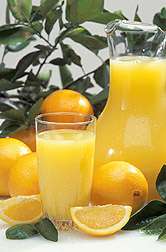March 11, 2009 weblog
Housewife Remedy for Scurvy Preceded Medical Discovery

(PhysOrg.com) -- A 100-page handwritten book by Mrs. Ebot Mitchell written in 1707 on household remedies contains among other things a recipe to treat scurvy. The recipe containing extracts from plants, orange juice, white wine or beer preceded the official medical treatment recommended by James Lind, a British naval surgeon in the late 1740's. Unfortunately, even James Lind's research was not implemented by the British Admiralty until late in the 1700's. Mrs. Mitchell's little handbook entitled "Ebot Mitchell Her Book 1707" was discovered in a house in Hasfield, Gloucestershire and is expected to fetch at auction around $831 (600 GBP) at Bonhams in London on March 24.
Scurvy is a disease which is the result of a diet deficient in Vitamin C. Egyptians recorded the symptoms of the disease as far back as 1550 B.C. James Lind, a British naval surgeon began his investigation of scurvy following the catastrophic world-wide sea voyage of Commander George Anson in the early 1740's wherein only 145 out of some 1100 sailors survived due to scurvy. Dr. Lind found that lemon or lime juice was effective in treating scurvy and recommended all seafaring voyages require sailors to imbibe the juice. The order was not officially approved until late in the 1700s by British Admiralty.
According to Professor Kumaravel Rajakumar MD, Department of Pediatrics, University of Pittsburgh School of Medicine, while the numbers declined in incidences of scurvy among British seafaring voyages a new crop of "land scurvy" developed during the 19th century. Individuals who were affected by the Great Potato Famine, and service members of the American Revolution and Crimean Wars, Arctic explorers and the California Gold Rush mining camps developed scurvy. Again, the culprit was a lack of Vitamin C (ascorbic acid) in the diet.
Pediatric scurvy was identified by Francis Glisson in 1650 in co-occurrence with infantile rickets. His observations and report did not surface for another 200-years. By the end of the 19th century, infantile scurvy was recognized in Britain and the United States and was attributed to the practice of heating milk and process foods deficient in Vitamin C. Eventually, infantile scurvy in the United States was nearly eradicated by supplementing heated milk formulas with fruits, vegetables and potatoes.
According to Dr. Rajakumar,"the human body lacks the ability to synthesize and make Vitamin C and therefore depends on exogenous dietary sources to meet Vitamin C needs. Consumption of fruits and vegetables or diets fortified with Vitamin C are essential to avoid ascorbic acid deficiency." The pathologic manifestations of Vitamin C deficiency include impaired collagen synthesis which can be observed in defective dentine formation, hemorrhaging in the gums, and loss of teeth. Hemorrhaging is a key feature and it can occur in any organ.
Today, infantile scurvy and adult scurvy rarely occurs in developed nations. There has been a significant rise in incidences of scurvy in Refugee Camps and it is reported to be in epidemic proportions in this population. Sudden death due to cardiac arrest is reported among adults and children with scurvy.
According to a manuscript specialist, Mrs. Mitchell's recipe to treat and prevent scurvy was "spot on" with the exception of the wine and beer ingredients. Perhaps, Mrs. Mitchell considered Mary Poppin's advice, that 'a spoon full of sugar, makes the medicine go down, in the most delightful way.'
© 2009 PhysOrg.com


















